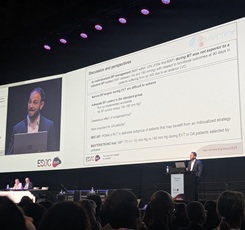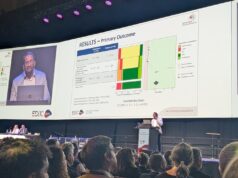
The DETERMINE randomised controlled trial (RCT) has found that individualised blood pressure (BP) management during mechanical thrombectomy for patients with anterior large vessel occlusion (LVO) stroke did not lead to improved functional outcomes at 90 days compared to the current standard of care. These data were recently presented for the first time at the 11th European Stroke Organisation Conference (ESOC; 21–23 May, Helsinki, Finland).
“Overall, while haemodynamic control during mechanical thrombectomy seems necessary, the current findings suggest that any potential benefit of individualised BP management on functional outcome is likely modest, and should not delay or restrict access to mechanical thrombectomy, which remains the most critical factor influencing clinical outcome,” said Benjamin Maïer (Rothschild Foundation, Paris, France), principal investigator for DETERMINE, who presented these results at ESOC 2025.
Despite high rates of successful reperfusion, many patients undergoing mechanical thrombectomy for acute ischaemic stroke due to anterior LVO experience poor outcomes, with one potential contributor believed to be suboptimal BP management during the procedure. Current guidelines apply a uniform BP threshold to all patients, disregarding individual physiological differences that may influence cerebral perfusion. In general surgery, the randomised INPRESS trial previously demonstrated that an individualised BP management strategy was superior to standard BP management in reducing a composite endpoint relating to organ dysfunction.
DETERMINE—a multicentre, open-label, blinded-endpoint RCT conducted at eight academic comprehensive stroke centres in France—set out to assess whether an individualised BP management approach during mechanical thrombectomy (mean arterial pressure [MAP] maintained within 10% of the first pre-thrombectomy MAP measurement) could improve 90-day functional outcomes in patients undergoing the procedure for anterior LVO stroke. From March 2021 to September 2023, 433 patients were randomised to either an individualised BP group (n=215) or a control BP group (n=218).
The investigators found that, after 90 days, favourable functional outcomes (modified Rankin scale [mRS] score of 0–2) were observed in 44.2% of patients in the individualised BP group versus 48.8% in the control group—a difference that was not statistically significant (adjusted odds ratio, 0.82; 95% confidence interval [CI], 0.54–1.24; p=0.34). Mortality and rates of symptomatic intracranial haemorrhage were also comparable between the two groups.
“The results of the DETERMINE trial highlight several key points,” Maïer commented. “First, they underscore the feasibility challenges of maintaining BP within narrow limits during mechanical thrombectomy, confirming findings from the INDIVIDUATE and IDEAL trials. Second, haemodynamic control in the standard care group (systolic BP within 140–180mmHg) seems adequate, limiting BP variability compared to the individualised group. Further randomised studies will be needed to define the optimal haemodynamic targets during mechanical thrombectomy, potentially involving alternative agents to norepinephrine or individualised management strategies.”
From these data, the researchers conclude that—although individualised BP management during mechanical thrombectomy did not improve 90-day outcomes—their findings provide “important evidence” to guide intraprocedural BP management and reinforce current recommendations, which emphasise maintaining systolic BP within a defined range during mechanical thrombectomy to avoid hypotension-related harm without complicating clinical protocols.










